A New Era in Medical Diagnosis
In an exciting development in the field of medicine, a revolutionary tool has emerged that promises to transform the way we detect viral diseases.
Developed by UC Santa Cruz electrical and computer engineering expert Holger Schmidt along with his team of collaborators, this innovative tool combines optofluids and nanopores to quickly and easily perform disease screening.
Unprecedented Precision and Efficiency
Tests carried out with this technology have shown results comparable to and even superior to those of PCR, the current standard in precision for viral tests, but with the advantage of being more agile and accessible.
This tool is capable of detecting both COVID-19 and the Zika virus with an accuracy equal to or greater than high-precision PCR tests, and does so in a matter of hours instead of days.
The Future of Medical Diagnosis
The potential of this innovation is limitless. Not only does it promise to revolutionize the detection of viral diseases, but it could also usher in a new era in medical diagnosis.
The diagnostic process, which previously required expensive equipment and highly trained personnel, is now simplified thanks to this innovative technology.
Simplicity and Accessibility
Unlike PCR tests, which are complex and require specialized chemical reactions, this new diagnostic system requires little sample preparation and does not involve amplification of viral DNA or RNA, which considerably speeds up the process.
Furthermore, by not relying on the amplification of genetic material, this tool is capable of detecting additional biomarkers, such as proteins, making it even more versatile and precise.
An Innovation of Impactful Dimensions
The system developed by Schmidt and his team combines optofluidics, which allows the control of fluids using light beams, with nanopore technology to count individual nucleic acids, making it a compact and highly efficient solution.
Its innovative design allows testing with a wide variety of biofluids, from saliva to throat swabs, making it easier to study and understand how diseases spread in different organisms.
The Path Towards the Future
As this technology moves toward commercialization, we see a promising future where medical diagnosis will be faster, more accurate, and more accessible than ever.
With potential applications that go beyond virus detection, this innovation could pave the way for early diagnoses of a wide range of diseases, from viruses to more complex health conditions such as cancer.
While there is still some way to go before this technology hits the market, its potential impact on medicine is undeniable and exciting.
